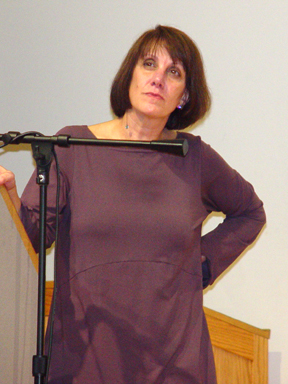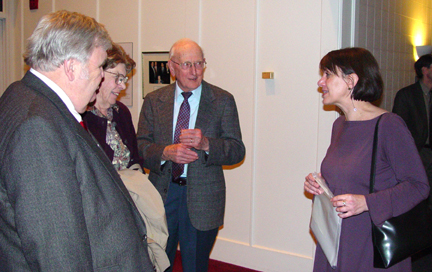 Barbie Zelizer gave the 2003 Brigance Forum Lecture |
Zelizer, associate professor of communications at the Annenberg School of Communications at the University of Pennsylvania, titled her speech “Extraordinary Events, Ordinary Coverage: When Images from the Past Shape Journalism.”
Her remarks, prepared months ago, were especially timely given the unfolding extraordinary events in the Middle East. Zelizer contends that regardless of medium, journalists and editors fall into predictable patterns when crisis news breaks, whether it’s a tragedy like 9/11, the Columbia Shuttle disaster, or troops descending on Baghdad.
“In working as reporters and editors, journalists agree to myriad interpretations and strategies regarding who reports the news, what gets reported, and how,” she says. “So that when our missiles attack Baghdad or the Columbia Shuttle explosion occurs, we expect certain things from our journalists. We know that, for at least the first few days, there will be no pictures of human gore, no reports of infighting either amongst the military or the Shuttle crew, no probing investigation of what went wrong.”
 Joe O'Rourke, Marion and Vic Powell, and Barbie Zelizer |
Zelizer used as an example the "wasted" news space devoted to memories of Iwo Jima at the moment firefighters raised an American flag in the rubble of the fallen World Trade Center towers. She contends that at times like 9/11, journalists struggle to accurately report the scope of the tragedy, often because they themselves become part of it and fall back on the work of memory.
These events signal "a linkage point by which journalists and we as publics behind them willingly forgo the prescribed standards of journalistic practice, and it is here that collective memory and journalists positioning as agents of collective memory steps in," says Zelizer.
"All of this is a long way of saying that when acting as agents of memory, journalists might find themselves doing things that are not particularly good for journalism that upset and possibly undermine the journalistic value of their coverage."
Photography, says Zelizer, is well suited to help the public move through periods of trauma. Frozen images offer a record of fact, and viewers can linger with an image until disbelief has subsided.
However, too often, according to Zelizer, editors choose to portray tragic events with predictable, pattered photographs that fall into two categories: images that "bear witness" and the "about to die moment."
Photos of people bearing witness—humans forced to see what happened as a way of taking responsibility for the enormous consequences of the tragedy—are too often used and are rarely newsworthy in a purely journalistic sense.
Similarly, the "about to die moments"have great value for journalists because they tend to catch a tragic moment in the middle, providing a sequence that forces a viewer only to imagine that which is about to happen. Zelizer cited the countless use of photos of the burning World Trade Center towers as examples of such images, and how they have become iconic symbols of the tragedy.
"Because death's depiction may not coincide with that which is most visually powerful and because of the long standing discomfort with showing graphic pictures of dead bodies in the news, journalists readily defer to the 'about to die' images instead," she claims. "This both violates its worthiness at the time of the photo's initial display, as well as over time when a less newsworthy photo often becomes the iconic image by which an event is remembered."
When crisis strikes, journalistic standards are abandoned. The search for truth in reporting is often overshadowed by symbols and recollections of the past. Zelizer contends that the lack of standards for the use of photography in such times facilitates their use as tools for shaping public opinion.
"With memory serving like the material by which this is accomplished," says Zelizer, "we need to think more critically about what such ends suggest for the viability of a healthy and contested public sphere."
Zelizer disagrees with the media's decision not to show video or images of wounded and dead American POWs being held in Iraq. The lack of images—of visual evidence—leads to poor or wrongly made judgments.
"There is a terroristic element about journalism that allows it masquerade itself, to slip under our mechanism for detection and to provide unsatisfactory performances at a time when we are most likely to forgive it its failing."